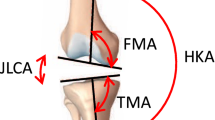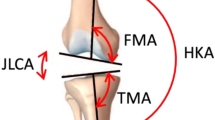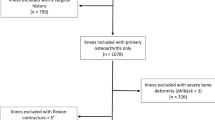Abstract
Purpose
Restricted kinematic alignment (rKA) in total knee arthroplasty (TKA) aims to restore native soft tissue laxities while limiting alignment extremes that risk prosthetic failure. However, there is no consensus where restricted boundaries (RB) should be set. This study aims to determine the proportion of limbs in which constitutional alignment and joint line obliquity (JLO) would be restored with various RB scenarios, to inform decision making in rKA TKA.
Methods
The mechanical hip–knee–ankle (mHKA) angle, arithmetic hip–knee–ankle (aHKA) angle, lateral distal femoral angle (LDFA) and medial proximal tibial angle (MPTA) were measured on radiographs of 500 normal knees. Incrementally wider RBs were then applied. The proportion of limbs within each increment was determined when RBs were applied only to HKA, or to HKA, LDFA and MPTA together. In addition, the proportion of limbs within published adjusted mechanical alignment (aMA) and rKA protocols were determined, as well as those within one, two and three standard deviations of the means for HKA, LDFA and MPTA.
Results
When restrictions to mHKA alone were applied, 74.0% and 97.8% of knees were captured with boundaries of ± 3° and ± 6° respectively. However, when the same boundaries to HKA were also applied to MPTA and LDFA, 36.2% and 91.0% of knees were captured respectively, highlighting the limiting effect that JLO has on restoration of normal knee phenotypes. When comparing previously published boundaries, aMA of 0° ± 3° captured 36.2%; rKA of 0° ± 3 for HKA and 85° to 95° for LDFA/MPTA captured 67.8%; rKA of − 5° to 4° HKA and 86°–93° for LDFA/MPTA captured 63%; and rKA of − 6° to + 3° for HKA and 84°–93° for LDFA/MPTA captured 85.4%.
Conclusion
The greatest proportions of normal knee phenotypes were captured with boundaries that were centred around population means for HKA and JLO. Further, these findings demonstrate that restricting the JLO has a significant limiting influence on restoration of normal knee phenotypes beyond that of restricting HKA alone.
Level of evidence
III.



Similar content being viewed by others
References
Almaawi AM, Hutt JRB, Masse V, Lavigne M, Vendittoli PA (2017) The impact of mechanical and restricted kinematic alignment on knee anatomy in total knee arthroplasty. J Arthroplasty 32:2133–2140
An VVG, Twiggs J, Leie M, Fritsch BA (2019) Kinematic alignment is bone and soft tissue preserving compared to mechanical alignment in total knee arthroplasty. Knee 26:466–476
Bellemans J, Colyn W, Vandenneucker H, Victor J (2012) The Chitranjan Ranawat award: is neutral mechanical alignment normal for all patients? The concept of constitutional varus. Clin Orthop Relat Res 470:45–53
Berend ME, Ritter MA, Meding JB, Faris PM, Keating EM, Redelman R et al (2004) The Chetranjan ranawat award: tibial component failure mechanisms in total knee arthroplasty®. Clin Orthop Relat Res 428:26–34
Blakeney W, Beaulieu Y, Kiss MO, Riviere C, Vendittoli PA (2019) Less gap imbalance with restricted kinematic alignment than with mechanically aligned total knee arthroplasty: simulations on 3-D bone models created from CT-scans. Acta Orthop 90:602–609
Blakeney W, Beaulieu Y, Puliero B, Kiss MO, Vendittoli PA (2019) Bone resection for mechanically aligned total knee arthroplasty creates frequent gap modifications and imbalances. Knee Surg Sports Traumatol Arthrosc. https://doi.org/10.1007/s00167-019-05562-8
Blakeney W, Clement J, Desmeules F, Hagemeister N, Riviere C, Vendittoli PA (2018) Kinematic alignment in total knee arthroplasty better reproduces normal gait than mechanical alignment. Knee Surg Sports Traumatol Arthrosc. https://doi.org/10.1007/s00167-018-5174-1
Bonner TJ, Eardley WG, Patterson P, Gregg PJ (2011) The effect of post-operative mechanical axis alignment on the survival of primary total knee replacements after a follow-up of 15 years. J Bone Joint Surg Br 93:1217–1222
Chang JS, Kayani B, Wallace C, Haddad FS (2021) Functional alignment achieves soft tissue balance in total knee arthroplasty as measured with quantitative sensor-guided technology. Bone Joint J. https://doi.org/10.1302/0301-620x.103b.Bjj-2020-0940.R11-8
Fang DM, Ritter MA, Davis KE (2009) Coronal alignment in total knee arthroplasty: just how important is it? J Arthroplasty 24:39–43
Hadi M, Barlow T, Ahmed I, Dunbar M, McCulloch P, Griffin D (2015) Does malalignment affect revision rate in total knee replacements: a systematic review of the literature. Springerplus 4:835
Hetaimish BM, Khan MM, Simunovic N, Al-Harbi HH, Bhandari M, Zalzal PK (2012) Meta-analysis of navigation vs conventional total knee arthroplasty. J Arthroplasty 27:1177–1182
Hirschmann MT, Hess S, Behrend H, Amsler F, Leclercq V, Moser LB (2019) Phenotyping of hip–knee–ankle angle in young non-osteoarthritic knees provides better understanding of native alignment variability. Knee Surg Sports Traumatol Arthrosc 27:1378–1384
Hirschmann MT, Moser LB, Amsler F, Behrend H, Leclercq V, Hess S (2019) Phenotyping the knee in young non-osteoarthritic knees shows a wide distribution of femoral and tibial coronal alignment. Knee Surg Sports Traumatol Arthrosc 27:1385–1393
Hirschmann MT, Moser LB, Amsler F, Behrend H, Leclerq V, Hess S (2019) Functional knee phenotypes: a novel classification for phenotyping the coronal lower limb alignment based on the native alignment in young non-osteoarthritic patients. Knee Surg Sports Traumatol Arthrosc 27:1394–1402
Howell SM, Howell SJ, Kuznik KT, Cohen J, Hull ML (2013) Does a kinematically aligned total knee arthroplasty restore function without failure regardless of alignment category? Clin Orthop Relat Res 471:1000–1007
Howell SM, Kuznik K, Hull ML, Siston RA (2008) Results of an initial experience with custom-fit positioning total knee arthroplasty in a series of 48 patients. Orthopedics 31:857–863
Howell SM, Shelton TJ, Hull ML (2018) Implant survival and function ten years after kinematically aligned total knee arthroplasty. J Arthroplasty 33:3678–3684
Hutt JR, LeBlanc MA, Masse V, Lavigne M, Vendittoli PA (2016) Kinematic TKA using navigation: surgical technique and initial results. Orthop Traumatol Surg Res 102:99–104
Insall JN, Binazzi R, Soudry M, Mestriner LA (1985) Total knee arthroplasty. Clin Orthop Relat Res 192:13–22
Klasan A, de Steiger R, Holland S, Hatton A, Vertullo CJ, Young SW (2020) Similar risk of revision after kinematically aligned, patient-specific instrumented total knee arthroplasty, and all other total knee arthroplasty: combined results from the Australian and New Zealand joint replacement registries. J Arthroplasty. https://doi.org/10.1016/j.arth.2020.05.065
MacDessi SJ, Griffiths-Jones W, Chen DB, Griffiths-Jones S, Wood JA, Diwan AD et al (2020) Restoring the constitutional alignment with a restrictive kinematic protocol improves quantitative soft-tissue balance in total knee arthroplasty: a randomized controlled trial. Bone Joint J 102-B:117–124
MacDessi SJ, Griffiths-Jones W, Harris IA, Bellemans J, Chen DB (2020) The arithmetic HKA (aHKA) predicts the constitutional alignment of the arthritic knee compared to the normal contralateral knee. Bone Joint Open 1:339–345
MacDessi SJ, Griffiths-Jones W, Harris IA, Bellemans J, Chen DB (2021) Coronal Plane Alignment of the Knee (CPAK) classification. Bone Joint J 103-B:329–337
Magnussen RA, Weppe F, Demey G, Servien E, Lustig S (2011) Residual varus alignment does not compromise results of TKAs in patients with preoperative varus. Clin Orthop Relat Res 469:3443–3450
Mason JB, Fehring TK, Estok R, Banel D, Fahrbach K (2007) Meta-analysis of alignment outcomes in computer-assisted total knee arthroplasty surgery. J Arthroplasty 22:1097–1106
McEwen P, Balendra G, Doma K (2019) Medial and lateral gap laxity differential in computer-assisted kinematic total knee arthroplasty. Bone Joint J 101-B:331–339
McEwen P, Dlaska C, Jovanovic I, Doma K, Brandon B (2019) Computer assisted kinematic and mechanical axis total knee arthroplasty: a prospective randomized controlled trial of bilateral simultaneous surgery. J Arthroplasty. https://doi.org/10.1016/j.arth.2019.08.064
Nakamura S, Tian Y, Tanaka Y, Kuriyama S, Ito H, Furu M et al (2017) The effects of kinematically aligned total knee arthroplasty on stress at the medial tibia: a case study for varus knee. Bone Joint Res 6:43–51
Niki Y, Nagura T, Nagai K, Kobayashi S, Harato K (2018) Kinematically aligned total knee arthroplasty reduces knee adduction moment more than mechanically aligned total knee arthroplasty. Knee Surg Sports Traumatol Arthrosc 26:1629–1635
Oussedik S, Abdel MP, Victor J, Pagnano MW, Haddad FS (2020) Alignment in total knee arthroplasty. Bone Joint J 102-B:276–279
Paley D, Pfeil J (2000) Principles of deformity correction around the knee. Orthopade 29:18–38
Ritter MA, Faris PM, Keating EM, Meding JB (1994) Postoperative alignment of total knee replacement. Its effect on survival. Clin Orthop Relat Res 209:153–156
Vendittoli P-A, Rivière C, MacDessi S (2020) The rebirth of computer-assisted surgery. Precise prosthetic implantation should be considered when targeting individualized alignment goals in total knee arthroplasty. Knee Surg Sports Traumatol Arthrosc. https://doi.org/10.1007/s00167-020-06295-9
Winnock de Grave P, Luyckx T, Claeys K, Tampere T, Kellens J, Muller J et al (2020) Higher satisfaction after total knee arthroplasty using restricted inverse kinematic alignment compared to adjusted mechanical alignment. Knee Surg Sports Traumatol Arthrosc. https://doi.org/10.1007/s00167-020-06165-4
Funding
There was no funding source for this study.
Author information
Authors and Affiliations
Corresponding author
Additional information
Publisher's Note
Springer Nature remains neutral with regard to jurisdictional claims in published maps and institutional affiliations.
Rights and permissions
About this article
Cite this article
MacDessi, S.J., Allom, R.J., Griffiths-Jones, W. et al. The importance of joint line obliquity: a radiological analysis of restricted boundaries in normal knee phenotypes to inform surgical decision making in kinematically aligned total knee arthroplasty. Knee Surg Sports Traumatol Arthrosc 30, 2931–2940 (2022). https://doi.org/10.1007/s00167-022-06872-0
Received:
Accepted:
Published:
Issue Date:
DOI: https://doi.org/10.1007/s00167-022-06872-0




